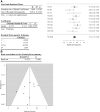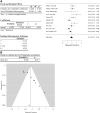Scoping Review and Meta-Analysis Suggests that Cannabis Use May Reduce Cancer Risk in the United States
- PMID: 33998861
- PMCID: PMC8612444
- DOI: 10.1089/can.2019.0095
Scoping Review and Meta-Analysis Suggests that Cannabis Use May Reduce Cancer Risk in the United States
Abstract
Introduction:Cannabis smoke contains carcinogens similar to tobacco, in addition to compounds with antitumor activity. Cannabis use reduces the risk of obesity and cannabinoids inhibit chronic inflammation, known causes of cancer. The net effect of Cannabis use on cancer risk is not known. Objective: To examine the association between Cannabis use and cancer risk in the United States. Methods: Identify and analyze published data on cancer risk in Cannabis users. Results: A total of 55 data points, consisting of risk ratios of cancer in Cannabis users and nonusers, were identified from 34 studies. Of these, 5 did not contain data essential for inclusion in the meta-analysis. The remaining data showed a nonsignificant trend to an association with reduced risk (relative risk [RR]=0.90, p>0.06, N=50) although heterogeneity is high (I2=72.4%). Removal of data with high risk of selection bias (defined as those from North Africa and those that failed to adjust for tobacco) and data with high risk of performance bias (defined as those with fewer than 20 cases or controls among Cannabis users) resulted in an RR <1.0 (RR=0.86, p<0.017, N=24) and large effect size (Hedges g=0.66), but did not decrease heterogeneity (I2=74.9). Of all cancer sites, only testicular cancer showed an RR value >1, although this was not significant and had a negligible effect size (RR=1.12, p=0.3, Hedges g=0.02). Following removal of testicular cancers the remaining data showed a decrease in risk (RR=0.87, p<0.025, N=41). Cancers of the head and neck showed a negative association with cancer risk (RR=0.83, p<0.05), with a large effect size (Hedges g=0.55), but high heterogeneity (I2=79.2%). RR did not reach statistical significance in the remaining cancer site categories (lung, testicular, obesity-associated, other). The data are consistent with a negative association between Cannabis use and nontesticular cancer, but there is low confidence in this result due to high heterogeneity and a paucity of data for many cancer types.
Keywords: Cannabis; cancer risk; marijuana; meta-analysis; scoping review.
Conflict of interest statement
No competing financial interests exist.
Figures









References
-
- Siegel RL, Miller KD, Jemal A. Cancer statistics, 2019. CA Cancer J Clin. 2019;69:7–34. - PubMed
-
- Velasco G, Sánchez C, Guzmán M. Towards the use of cannabinoids as antitumour agents. Nat Rev Cancer. 2012;12:436–444. - PubMed
-
- Bisogno T, Maccarrone M. Endocannabinoid signaling and its regulation by nutrients. BioFactors. 2014;40:373–380. - PubMed
Publication types
MeSH terms
Substances
LinkOut - more resources
Full Text Sources
Medical
